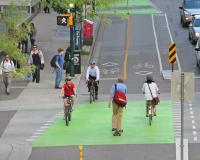
Vibrant Environment
Climate Change And Sustainability
All | Biodiversity | Climate Change and Sustainability | Environmental Justice | Governance and Rule of Law | Land Use and Natural Resources | Oceans and Coasts | Pollution Control

Part 1 of this blog presented the environmental and social impacts of the fashion industry, and argued for structural changes to address sustainability beyond greenwashing. Part 2 presents potential paths toward sustainability in the fashion industry.

The fashion industry is thirsty. Every year, it consumes 93 billion cubic meters of water—enough for the survival of over 5 million people. The problems within the fashion industry go beyond water use. Due to the rise in fast fashion, global clothing production has exponentially increased, doubling between 2000 and 2014. Fashion is now the second-most polluting industry worldwide.

Environmental Protection Agency chief Andrew Wheeler proudly details the administration’s deregulatory record in a Newsweek opinion article published in late July. He frames his success story within President Trump’s January 2017 executive order requiring agencies to eliminate two regulations for each new one. While Wheeler touts the avoided costs, he doesn’t mention the avoided benefits the repealed rules would have provided.

The National Oceanic and Atmospheric Administration (NOAA) reported in August that this year’s Gulf of Mexico dead zone was unexpectedly small—in fact, the third-smallest ever measure in the 34-year record. Interestingly, this comes just two months after NOAA had forecasted a larger-than-average dead zone in early June. The cause of this shift appears to be Hurricane Hanna, whose large, powerful waves agitated the water column, disrupting algal accumulation in the Gulf.

Almost one-quarter of all U.S. CO2 emissions come from fossil fuels extracted from public lands. Producing more than 274 million barrels of oil, 3.3 billion cubic feet of natural gas, and 302 million tons of coal each year, BLM’s management decisions have a significant impact on climate change. In this month’s issue of ELR—The Environmental Law Reporter, authors Jamie Gibbs Pleune, John Ruple, and Nada Wolff Culver argue that the Bureau has not only the authority, but a legal duty to mitigate climate change in its permitting decisions. Using existing legal structures, they provide a road map for requiring all new BLM oil and gas development to achieve net-zero emissions.

Electricity generation, one of the leading sources of greenhouse gas emissions, rarely accounts for the social cost of damages caused by carbon dioxide emissions. Embedding these costs into market rates is one way to address the pressing need for decarbonization. In this year’s Environmental Law and Policy Annual Review (ELPAR), a special issue of The Environmental Law Reporter, authors Bethany Davis Noll and Burcin Unel argue that addressing the price of emissions falls within the authority of the Federal Energy Regulatory Commission (FERC). The authors examine how imposing a cost on carbon aligns with FERC’s main goal of ensuring just and reasonable rates, and they explore opportunities and limits for FERC’s authority.

We have the solutions we need to build an equitable and just climate resilient future. Over the past year, coalitions of frontline environmental groups, labor organizations, tribal groups, and other mission-driven organizations in the United States have developed and published comprehensive policy platforms to address the climate crisis. These platforms outline federal, local, and state policy for building resilience and transitioning to renewable and regenerative economies.

With the sweeping and difficult changes brought on by the COVID-19 pandemic, including social distancing and an economic downturn with record-high unemployment, greenhouse gas (GHG) emissions have plummeted globally. Reductions in emissions for the year are projected to be between 4% and 7% globally and between 6.7% and 11% in the United States.

The coronavirus pandemic is affecting a variety of industries, from travel to retail to restaurants. But perhaps the hardest-hit are meat and poultry processing plants, which have been experiencing outbreaks throughout the United States. In April, President Trump issued an Executive Order declaring these plants “critical infrastructure” to make sure they stay open, and the number of cases in these plants continued to rise in the days and weeks that followed. According to the Midwest Center for Investigative Reporting, as of June 15 there have been over 25,000 reported positive cases tied to meatpacking facilities in at least 235 plants in 33 states, and at least 90 reported worker deaths at 39 plants in 24 states.

If you have walked across downtown Manhattan recently, you may have been blinded by the new colorful green pavement marking protected bike lanes. NYC is one of many cities flaunting their new bike safety initiatives in political speeches, tourist brochures, and subway ads. Given the multiple economic, health, and environmental benefits of replacing car trips with bike trips, their pride is well-deserved. But in order for such initiatives to serve all New Yorkers, they must go a step further.